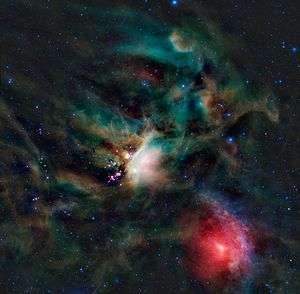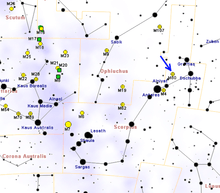Messier 80
| Messier 80 | |
|---|---|
|
| |
| Observation data (J2000 epoch) | |
| Class | II[1] |
| Constellation | Scorpius |
| Right ascension | 16h 17m 02.41s[2] |
| Declination | –22° 58′ 33.9″[2] |
| Distance | 32.6 kly (10.0 kpc)[3] |
| Apparent magnitude (V) | +7.87[4] |
| Apparent dimensions (V) | 10′.0 |
| Physical characteristics | |
| Mass | 5.02×105[5] M☉ |
| Radius | 48 ly |
| Metallicity | = –1.47[6] dex |
| Estimated age | 12.54[6] |
| Other designations | M80, NGC 6093, GCl 39[4] |
Messier 80 (also known as M80 or NGC 6093) is a globular cluster in the constellation Scorpius. It was discovered by Charles Messier in 1781.
The star cluster is located midway between α Scorpii (Antares) and β Scorpii in a field in the Milky Way that is rich in nebulae. It can be viewed with modest amateur telescopes as a mottled ball of light. With an apparent diameter of about 10' and at an estimated distance of 32,600 light-years, M80's spatial diameter is about 95 light-years. It contains several hundred thousand stars, and is among the more densely populated globular clusters in the Milky Way.
It contains a relatively large number of blue stragglers, stars that appear to be much younger than the cluster itself. It is thought these stars have lost part of their outer layers due to close encounters with other cluster members or perhaps the result of collisions between stars in the dense cluster. Images from the Hubble Space Telescope have shown districts of very high blue straggler densities, suggesting that the center of the cluster is likely to have a very high capture and collision rate.
On May 21, 1860, a nova was discovered in M80 that attained a magnitude of +7.0. The nova, variable star designation T Scorpii, reached an absolute magnitude of −8.5, briefly outshining the entire cluster.


References
- ↑ Shapley, Harlow; Sawyer, Helen B. (August 1927), "A Classification of Globular Clusters", Harvard College Observatory Bulletin (849): 11–14, Bibcode:1927BHarO.849...11S.
- 1 2 Goldsbury, Ryan; et al. (December 2010), "The ACS Survey of Galactic Globular Clusters. X. New Determinations of Centers for 65 Clusters", The Astronomical Journal, 140 (6): 1830–1837, arXiv:1008.2755
 , Bibcode:2010AJ....140.1830G, doi:10.1088/0004-6256/140/6/1830.
, Bibcode:2010AJ....140.1830G, doi:10.1088/0004-6256/140/6/1830. - ↑ Paust, Nathaniel E. Q.; et al. (February 2010), "The ACS Survey of Galactic Globular Clusters. VIII. Effects of Environment on Globular Cluster Global Mass Functions", The Astronomical Journal, 139 (2): 476–491, Bibcode:2010AJ....139..476P, doi:10.1088/0004-6256/139/2/476.
- 1 2 "SIMBAD Astronomical Object Database". Results for NGC 6093. Retrieved 2006-11-16.
- ↑ Boyles, J.; et al. (November 2011), "Young Radio Pulsars in Galactic Globular Clusters", The Astrophysical Journal, 742 (1): 51, arXiv:1108.4402
 , Bibcode:2011ApJ...742...51B, doi:10.1088/0004-637X/742/1/51.
, Bibcode:2011ApJ...742...51B, doi:10.1088/0004-637X/742/1/51. - 1 2 Forbes, Duncan A.; Bridges, Terry (May 2010), "Accreted versus in situ Milky Way globular clusters", Monthly Notices of the Royal Astronomical Society, 404 (3): 1203–1214, arXiv:1001.4289
 , Bibcode:2010MNRAS.404.1203F, doi:10.1111/j.1365-2966.2010.16373.x.
, Bibcode:2010MNRAS.404.1203F, doi:10.1111/j.1365-2966.2010.16373.x.
External links
![]() Media related to Messier 80 at Wikimedia Commons
Media related to Messier 80 at Wikimedia Commons
- Messier 80, SEDS Messier pages
- Messier 80, Galactic Globular Clusters Database page
- NASA Astronomy Picture of the Day: M80: A Dense Globular Cluster (July 7, 1999)
- Messier 80 at ESA/Hubble
- Messier 80 on WikiSky: DSS2, SDSS, GALEX, IRAS, Hydrogen α, X-Ray, Astrophoto, Sky Map, Articles and images
Coordinates: ![]() 16h 17m 02.51s, −22° 58′ 30.4″
16h 17m 02.51s, −22° 58′ 30.4″

